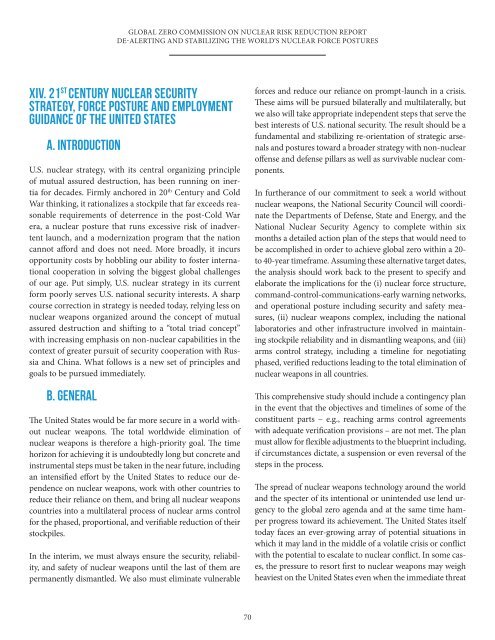global_zero_commission_on_nuclear_risk_reduction_report
global_zero_commission_on_nuclear_risk_reduction_report
global_zero_commission_on_nuclear_risk_reduction_report
You also want an ePaper? Increase the reach of your titles
YUMPU automatically turns print PDFs into web optimized ePapers that Google loves.
GLOBAL ZERO COMMISSION ON NUCLEAR RISK REDUCTION REPORTDE-ALERTING AND STABILIZING THE WORLD’S NUCLEAR FORCE POSTURESXIV. 21 ST CENTURY NUCLEAR SECURITYSTRATEGY, FORCE POSTURE AND EMPLOYMENTGUIDANCE OF THE UNITED STATESA. INTRODUCTIONU.S. <strong>nuclear</strong> strategy, with its central organizing principleof mutual assured destructi<strong>on</strong>, has been running <strong>on</strong> inertiafor decades. Firmly anchored in 20 th Century and ColdWar thinking, it rati<strong>on</strong>alizes a stockpile that far exceeds reas<strong>on</strong>ablerequirements of deterrence in the post-Cold Warera, a <strong>nuclear</strong> posture that runs excessive <strong>risk</strong> of inadvertentlaunch, and a modernizati<strong>on</strong> program that the nati<strong>on</strong>cannot afford and does not need. More broadly, it incursopportunity costs by hobbling our ability to foster internati<strong>on</strong>alcooperati<strong>on</strong> in solving the biggest <str<strong>on</strong>g>global</str<strong>on</strong>g> challengesof our age. Put simply, U.S. <strong>nuclear</strong> strategy in its currentform poorly serves U.S. nati<strong>on</strong>al security interests. A sharpcourse correcti<strong>on</strong> in strategy is needed today, relying less <strong>on</strong><strong>nuclear</strong> weap<strong>on</strong>s organized around the c<strong>on</strong>cept of mutualassured destructi<strong>on</strong> and shifting to a “total triad c<strong>on</strong>cept”with increasing emphasis <strong>on</strong> n<strong>on</strong>-<strong>nuclear</strong> capabilities in thec<strong>on</strong>text of greater pursuit of security cooperati<strong>on</strong> with Russiaand China. What follows is a new set of principles andgoals to be pursued immediately.B. GENERALThe United States would be far more secure in a world without<strong>nuclear</strong> weap<strong>on</strong>s. The total worldwide eliminati<strong>on</strong> of<strong>nuclear</strong> weap<strong>on</strong>s is therefore a high-priority goal. The timehoriz<strong>on</strong> for achieving it is undoubtedly l<strong>on</strong>g but c<strong>on</strong>crete andinstrumental steps must be taken in the near future, includingan intensified effort by the United States to reduce our dependence<strong>on</strong> <strong>nuclear</strong> weap<strong>on</strong>s, work with other countries toreduce their reliance <strong>on</strong> them, and bring all <strong>nuclear</strong> weap<strong>on</strong>scountries into a multilateral process of <strong>nuclear</strong> arms c<strong>on</strong>trolfor the phased, proporti<strong>on</strong>al, and verifiable reducti<strong>on</strong> of theirstockpiles.In the interim, we must always ensure the security, reliability,and safety of <strong>nuclear</strong> weap<strong>on</strong>s until the last of them arepermanently dismantled. We also must eliminate vulnerableforces and reduce our reliance <strong>on</strong> prompt-launch in a crisis.These aims will be pursued bilaterally and multilaterally, butwe also will take appropriate independent steps that serve thebest interests of U.S. nati<strong>on</strong>al security. The result should be afundamental and stabilizing re-orientati<strong>on</strong> of strategic arsenalsand postures toward a broader strategy with n<strong>on</strong>-<strong>nuclear</strong>offense and defense pillars as well as survivable <strong>nuclear</strong> comp<strong>on</strong>ents.In furtherance of our commitment to seek a world without<strong>nuclear</strong> weap<strong>on</strong>s, the Nati<strong>on</strong>al Security Council will coordinatethe Departments of Defense, State and Energy, and theNati<strong>on</strong>al Nuclear Security Agency to complete within sixm<strong>on</strong>ths a detailed acti<strong>on</strong> plan of the steps that would need tobe accomplished in order to achieve <str<strong>on</strong>g>global</str<strong>on</strong>g> <str<strong>on</strong>g>zero</str<strong>on</strong>g> within a 20-to 40-year timeframe. Assuming these alternative target dates,the analysis should work back to the present to specify andelaborate the implicati<strong>on</strong>s for the (i) <strong>nuclear</strong> force structure,command-c<strong>on</strong>trol-communicati<strong>on</strong>s-early warning networks,and operati<strong>on</strong>al posture including security and safety measures,(ii) <strong>nuclear</strong> weap<strong>on</strong>s complex, including the nati<strong>on</strong>allaboratories and other infrastructure involved in maintainingstockpile reliability and in dismantling weap<strong>on</strong>s, and (iii)arms c<strong>on</strong>trol strategy, including a timeline for negotiatingphased, verified reducti<strong>on</strong>s leading to the total eliminati<strong>on</strong> of<strong>nuclear</strong> weap<strong>on</strong>s in all countries.This comprehensive study should include a c<strong>on</strong>tingency planin the event that the objectives and timelines of some of thec<strong>on</strong>stituent parts – e.g., reaching arms c<strong>on</strong>trol agreementswith adequate verificati<strong>on</strong> provisi<strong>on</strong>s – are not met. The planmust allow for flexible adjustments to the blueprint including,if circumstances dictate, a suspensi<strong>on</strong> or even reversal of thesteps in the process.The spread of <strong>nuclear</strong> weap<strong>on</strong>s technology around the worldand the specter of its intenti<strong>on</strong>al or unintended use lend urgencyto the <str<strong>on</strong>g>global</str<strong>on</strong>g> <str<strong>on</strong>g>zero</str<strong>on</strong>g> agenda and at the same time hamperprogress toward its achievement. The United States itselftoday faces an ever-growing array of potential situati<strong>on</strong>s inwhich it may land in the middle of a volatile crisis or c<strong>on</strong>flictwith the potential to escalate to <strong>nuclear</strong> c<strong>on</strong>flict. In some cases,the pressure to resort first to <strong>nuclear</strong> weap<strong>on</strong>s may weighheaviest <strong>on</strong> the United States even when the immediate threat70


